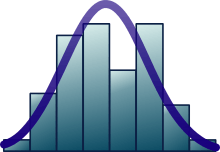Notation in probability and statistics
| Probability |
|---|
 |
| Statistics |
|---|
 |
|
Probability theory and statistics have some commonly used conventions, in addition to standard mathematical notation and mathematical symbols.
Probability theory
- Random variables are usually written in upper case roman letters: X, Y, etc.
- Particular realizations of a random variable are written in corresponding lower case letters. For example x1, x2, …, xn could be a sample corresponding to the random variable X and a cumulative probability is formally written to differentiate random variable from realization.
- The probability is sometimes written to distinguish it from other functions and measure P so as to avoid having to define " P is a probability" and is short for , where is an event and a corresponding random variable.
- or indicates the probability that events A and B both occur.
- or indicates the probability of either event A or event B occurring ("or" in this case means one or the other or both).
- σ-algebras are usually written with upper case calligraphic (e.g. for the set of sets on which we define the probability P)
- Probability density functions (pdfs) and probability mass functions are denoted by lower case letters, e.g. f(x).
- Cumulative distribution functions (cdfs) are denoted by upper case letters, e.g. F(x).
- Survival functions or complementary cumulative distribution functions are often denoted by placing an overbar over the symbol for the cumulative:
- In particular, the pdf of the standard normal distribution is denoted by φ(z), and its cdf by Φ(z).
- Some common operators:
- E[X] : expected value of X
- var[X] : variance of X
- cov[X, Y] : covariance of X and Y
- X is independent of Y is often written or , and X is independent of Y given W is often written
- or
- , the posterior probability, is the probability of given , i.e., after is observed.
Statistics
- Greek letters (e.g. θ, β) are commonly used to denote unknown parameters (population parameters).
- A tilde (~) denotes "has the probability distribution of".
- Placing a hat, or caret, over a true parameter denotes an estimator of it, e.g., is an estimator for .
- The arithmetic mean of a series of values x1, x2, ..., xn is often denoted by placing an "overbar" over the symbol, e.g. , pronounced "x bar".
- Some commonly used symbols for sample statistics are given below:
- the sample mean ,
- the sample variance s2,
- the sample standard deviation s,
- the sample correlation coefficient r,
- the sample cumulants kr.
- Some commonly used symbols for population parameters are given below:
- the population mean μ,
- the population variance σ2,
- the population standard deviation σ,
- the population correlation ρ,
- the population cumulants κr.
Critical values
The α-level upper critical value of a probability distribution is the value exceeded with probability α, that is, the value xα such that F(xα) = 1 − α where F is the cumulative distribution function. There are standard notations for the upper critical values of some commonly used distributions in statistics:
- zα or z(α) for the Standard normal distribution
- tα,ν or t(α,ν) for the t-distribution with ν degrees of freedom
- or for the chi-squared distribution with ν degrees of freedom
- or F(α,ν1,ν2) for the F-distribution with ν1 and ν2 degrees of freedom
Linear algebra
- Matrices are usually denoted by boldface capital letters, e.g. A.
- Column vectors are usually denoted by boldface lower case letters, e.g. x.
- The transpose operator is denoted by either a superscript T (e.g. AT) or a prime symbol (e.g. A′).
- A row vector is written as the transpose of a column vector, e.g. xT or x′.
Abbreviations
Common abbreviations include:
- a.e. almost everywhere
- a.s. almost surely
- cdf cumulative distribution function
- cmf cumulative mass function
- df degrees of freedom (also )
- i.i.d. independent and identically distributed
- pdf probability density function
- pmf probability mass function
- r.v. random variable
- w.p. with probability; wp1 with probability 1
See also
- Glossary of probability and statistics
- Combinations and permutations
- Typographical conventions in mathematical formulae
- History of mathematical notation
References
- Halperin, Max; Hartley, H. O.; Hoel, P. G. (1965), "Recommended Standards for Statistical Symbols and Notation. COPSS Committee on Symbols and Notation", The American Statistician, 19 (3): 12–14, doi:10.2307/2681417, JSTOR 2681417
External links
- Earliest Uses of Symbols in Probability and Statistics, maintained by Jeff Miller.
This article is issued from Wikipedia - version of the 12/1/2016. The text is available under the Creative Commons Attribution/Share Alike but additional terms may apply for the media files.